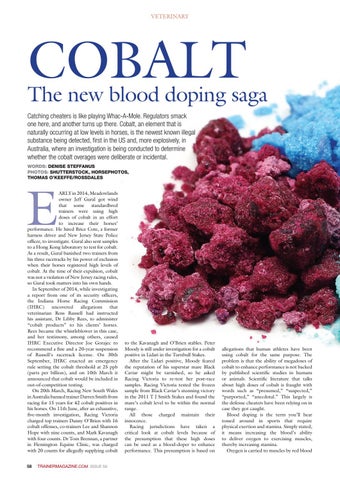VETERINARY
COBALT The new blood doping saga Catching cheaters is like playing Whac-A-Mole. Regulators smack one here, and another turns up there. Cobalt, an element that is naturally occurring at low levels in horses, is the newest known illegal substance being detected, first in the US and, more explosively, in Australia, where an investigation is being conducted to determine whether the cobalt overages were deliberate or incidental. WORDS: DeniSe SteffanuS PHOtOS: SHutteRStOCK, HORSePHOtOS, tHOmaS O’Keeffe/ROSSDaleS
E
ARLY in 2014, Meadowlands owner Jeff Gural got wind that some standardbred trainers were using high doses of cobalt in an effort to increase their horses’ performance. He hired Brice Cote, a former harness driver and New Jersey State Police officer, to investigate. Gural also sent samples to a Hong Kong laboratory to test for cobalt. As a result, Gural banished two trainers from his three racetracks by his power of exclusion when their horses registered high levels of cobalt. At the time of their expulsion, cobalt was not a violation of New Jersey racing rules, so Gural took matters into his own hands. In September of 2014, while investigating a report from one of its security officers, the Indiana Horse Racing Commission (IHRC) uncovered allegations that veterinarian Ross Russell had instructed his assistant, Dr Libby Rees, to administer “cobalt products” to his clients’ horses. Rees became the whistleblower in this case, and her testimony, among others, caused IHRC Executive Director Joe Gorajec to recommend a fine and a 20-year suspension of Russell's racetrack license. On 30th September, IHRC enacted an emergency rule setting the cobalt threshold at 25 ppb (parts per billion), and on 10th March it announced that cobalt would be included in out-of-competition testing. On 20th March, Racing New South Wales in Australia banned trainer Darren Smith from racing for 15 years for 42 cobalt positives in his horses. On 11th June, after an exhaustive, five-month investigation, Racing Victoria charged top trainers Danny O'Brien with 16 cobalt offenses, co-trainers Lee and Shannon Hope with nine counts, and Mark Kavanagh with four counts. Dr Tom Brennan, a partner in Flemington Equine Clinic, was charged with 20 counts for allegedly supplying cobalt
58
TRAINERMAGAZINE.COM ISSUE 50
to the Kavanagh and O’Brien stables. Peter Moody is still under investigation for a cobalt positive in Lidari in the Turnbull Stakes. After the Lidari positive, Moody feared the reputation of his superstar mare Black Caviar might be tarnished, so he asked Racing Victoria to re-test her post-race samples. Racing Victoria tested the frozen sample from Black Caviar’s stunning victory in the 2011 T J Smith Stakes and found the mare’s cobalt level to be within the normal range. All those charged maintain their innocence. Racing jurisdictions have taken a critical look at cobalt levels because of the presumption that these high doses can be used as a blood-doper to enhance performance. This presumption is based on
allegations that human athletes have been using cobalt for the same purpose. The problem is that the ability of megadoses of cobalt to enhance performance is not backed by published scientific studies in humans or animals. Scientific literature that talks about high doses of cobalt is fraught with words such as “presumed,” “suspected,” “purported,” “anecdotal.” This largely is the defense cheaters have been relying on in case they got caught. Blood doping is the term you’ll hear tossed around in sports that require physical exertion and stamina. Simply stated, it means increasing the blood’s ability to deliver oxygen to exercising muscles, thereby increasing stamina. Oxygen is carried to muscles by red blood
